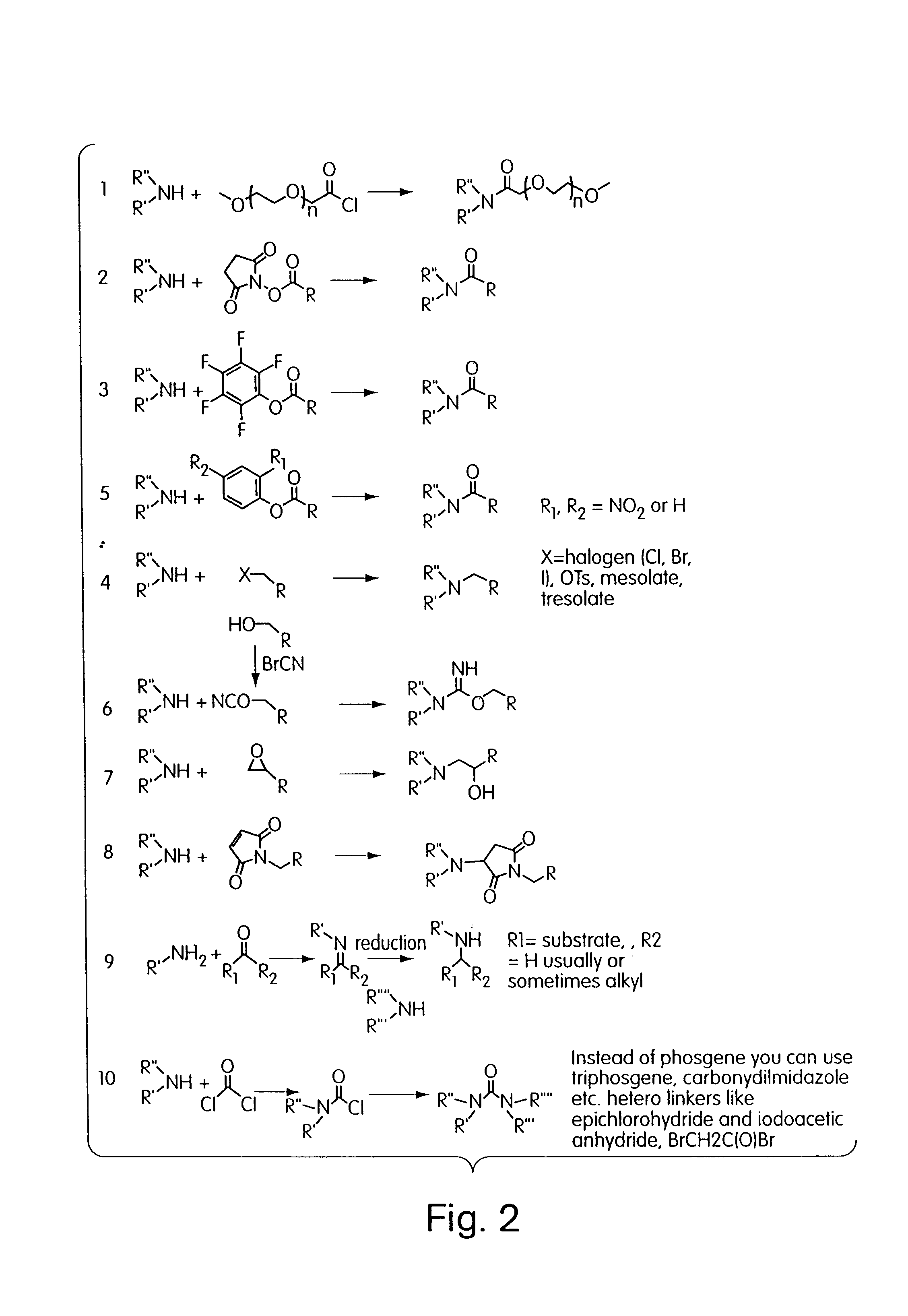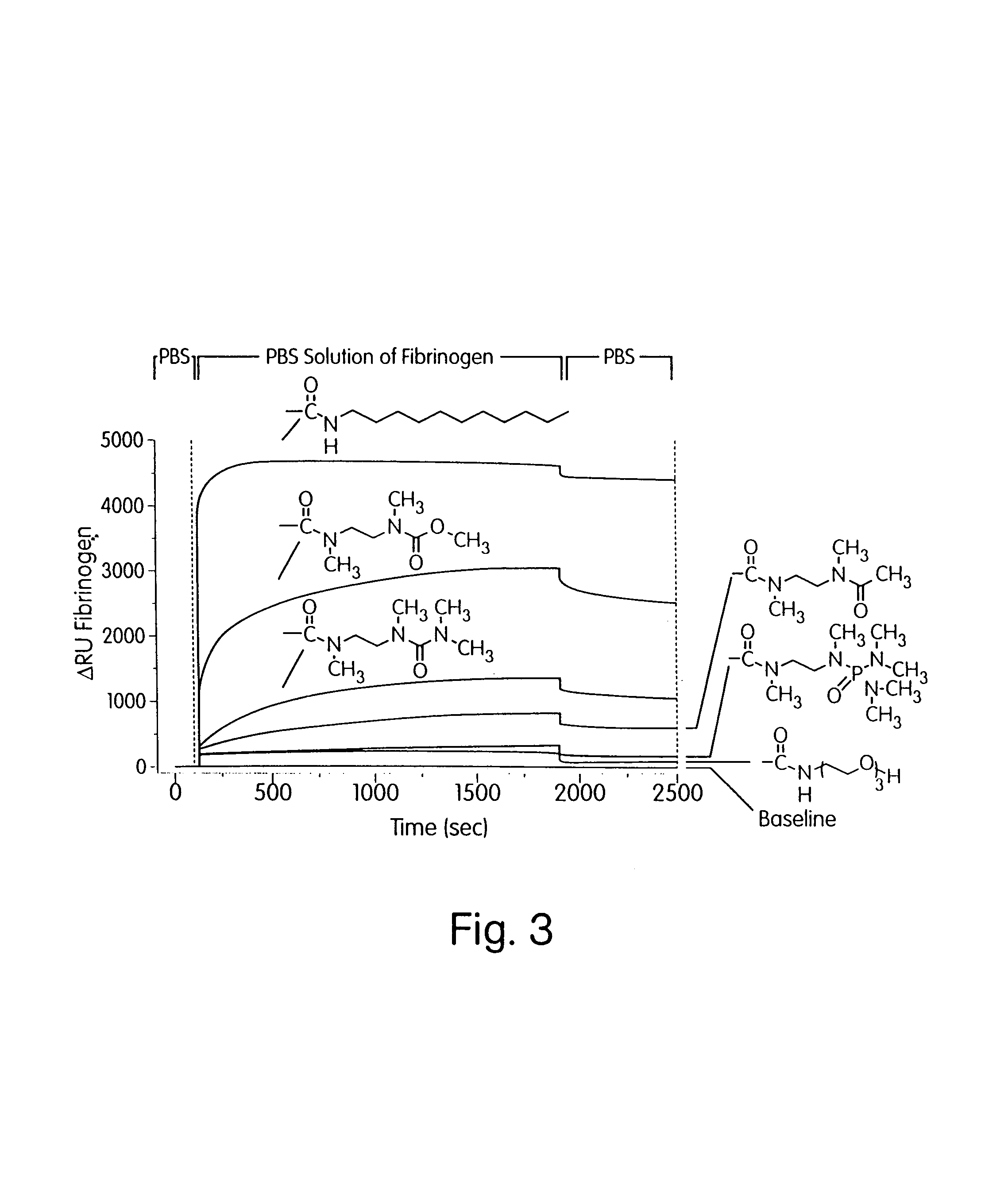Surfaces that resist the adsorption of biological species
a technology of biological species and surface, applied in the field of articles, can solve the problems of disadvantageous oligo(ethylene glycol) units
- Summary
- Abstract
- Description
- Claims
- Application Information
AI Technical Summary
Benefits of technology
Problems solved by technology
Method used
Image
Examples
example 1
SAMs That Resist the Adsorption of Proteins
[0148]Materials.
[0149]All chemicals used were reagent grade unless stated otherwise. Fibrinogen (from bovine plasma, F8630), lysozyme (egg white, E.C. 3.2.1.17, L6876), sodium dodecylsulfate (SDS), and phosphate buffered saline packets were purchased from Sigma (St. Louis, Mo.). Anhydrous N-methyl-2-pyrrolidinone (NMP), 16-mercaptohexadecanoic acid, trifluoroacetic anhydride (TFAA), N,N′-dimethyl-1,2-diaminoethane (HN(CH3)CH2CH2N(CH3)H), N,N,N′-trimethyl-1,2-diaminoethane (HN(CH3)CH2CH2N(CH3)2), CH3(CH2)11NH2, 1-amino-1-deoxy-D-sorbitol, di-tert-butyl dicarbonate, diisopropylethylarnine (DIPEA), sodium hydride, methyl iodide, tetramethyl phosphorodiamidic chloride ((CH3)2N)2P(O)Cl, and hydrazine were purchased from Aldrich (Milwaukee, Wis.). H2NCH2CON(CH3)2, (H2NCH2CONH2) and HN(CH3)CH2CON(CH3)2 were purchased from BACHEM (Bubendorf, Switzerland). Tri(ethylene glycol)monoamine (H2N(CH2CH2O)3H) was a gift from Texaco Chemical Company, which ...
example 2
SAMs That Resist the Adsorption of Cells, Bacteria and Mammalian Cells
[0167]This Example describes single-component SAMs which resist the adsorption of proteins from solution and the adhesion of Staphylococcus epidermidis, Staphylococcus aureus, and bovine capillary endothelial (BCE) cells. These surfaces present structurally diverse functional groups and allow forming structure property relationships between surfaces and their ability to resist the adsorption of proteins and the adhesion of cells. Structures of chemical chains in this Example are shown in FIG. 4. Resistance to the adsorption of proteins was screened and tested by SPR as described in Example 1. Results are shown in Table 3 and the SPR sensorgram of FIG. 5.
[0168]
TABLE 3Characterization of single-component SAMs that present groups that reduce the adsorption of protein from solution.The results from the mixed SAMs that present the same groups is given for comparison.Entry% ML% ML% Fib% ML% ML% LysθcofNo.iRNH2 or RSH3 m...
example 3
Polymeric Thin Films that Resist the Adsorption of Cells, Bacteria and Mammalian Cells
[0177]This Example describes the design and synthesis of thin, polymeric films that are covalently grafted on the surface of self-assembled monolayers (SAMs), and that resist the adsorption of proteins and the adhesion of bacteria. These surface films were prepared using a three-step process (FIG. 1). FIG. 1A: A single-component SAM of mercaptohexadecanoic acid was activated to present reactive interchain carboxylic anhydride groups on the surface. FIG. 1B: The reaction of this surface with polymeric amines generated a second surface presenting multiple amino groups in a thin, covalently grafted, polymer layer. FIG. 1C: The free amino groups on the immobilized polymers were acylated to introduce functional groups that resist the adsorption of proteins. The number of bacteria that adhered to the surface films that best resisted the adsorption of proteins was orders of magnitude lower than that measu...
PUM
| Property | Measurement | Unit |
|---|---|---|
| Fraction | aaaaa | aaaaa |
| Fraction | aaaaa | aaaaa |
| Fraction | aaaaa | aaaaa |
Abstract
Description
Claims
Application Information
 Login to View More
Login to View More - R&D
- Intellectual Property
- Life Sciences
- Materials
- Tech Scout
- Unparalleled Data Quality
- Higher Quality Content
- 60% Fewer Hallucinations
Browse by: Latest US Patents, China's latest patents, Technical Efficacy Thesaurus, Application Domain, Technology Topic, Popular Technical Reports.
© 2025 PatSnap. All rights reserved.Legal|Privacy policy|Modern Slavery Act Transparency Statement|Sitemap|About US| Contact US: help@patsnap.com



